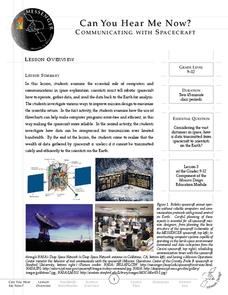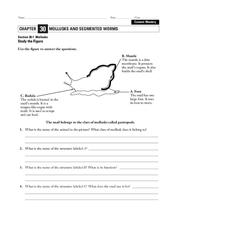National Institute of Open Schooling
p-Block Elements and Their Compounds – II
Ozone, made of three bonded oxygen atoms, is found 15-30 km above Earth, has a strong smell, is blue, and blocks sunlight from hitting the surface of Earth. The 22nd lesson in a series of 36 specifically focuses on the important elements...
MinuteEarth
How Tall Can Mountains Be?
Currently, the tallest mountain on Earth is Mount Everest at 8,848 meters above sea level. The video discusses how tall a mountain might reach based on gravity, rock density, and other factors such as plate tectonics and erosion.
Messenger Education
Can You Hear Me Now?—Communicating with Spacecraft
Radio signals transmitted to Pluto take five hours to reach their destination! In these two activities, young scientists explore data communication in space. In activity one, pupils learn how data is gathered and sent back to Earth....
It's About Time
Our Community's Place Among the Stars
But isn't the Milky Way a candy bar? Lead a detailed discussion on the complex topic of our solar system and the Milky Way Galaxy as the class explores stellar evolution, structure, and investigates the relationship between luminosity...
Maryland Department of Natural Resources
Eyes on Dissolved Oxygen
Learn about the factors that affect the way oxygen dissolves in salt water with a chemistry lab. After studying the molecular structure of water, young scientists figure out how aeration, temperature, and organic waste affect dissolved...
It's About Time
The Sun and Its Effects on Your Community
Why is the sun round? Examine this question, and others, with your pupils while teaching them how to live in a more earth-friendly environment. Pupils explore Sun composition and discuss how solar wind, sunspots, and solar energy affects...
It's About Time
Diversity in Living Things
How diverse is the world we live in compared to the way things used to be? Young biologists explore diverse organisms and relate the structure of each organism to its ability to survive in our current environmental conditions....
Crash Course
Ecosystem Ecology: Links in the Chain
A video starts by defining an ecosystem. It expands on the concept by covering trophic structure, primary producers, primary consumers, secondary consumers, tertiary consumers, detrivores, and bioaccumulation.
Teach Engineering
Skin and the Effects of Ultraviolet Radiation
Though UV radiation can damage skin, it isn't all bad. The third installment in a six-part series allows the class to study the structure and function of skin. They learn about the different types of skin cancer and the SPF rating...
MinuteEarth
Denizens of the Deep
Dive into a lesson on the habitat of Earth least studied. A creative lesson describes the characteristics of animals that live in the deepest depths of the ocean. It also shares the concern of scientists that fishing these depths may...
American Chemical Society
The Discovery of Fullerenes
Carbon is the most common element on earth, so the innovative discovery of a new type of carbon molecule won the 1996 Nobel Prize. In the ready-to-go instructional activity, scholars learn about C60 and how it has opened up the entire...
Crash Course
Conservation and Restoration Ecology
Address types of diversity, conservation biology, and restoration ecology. A video also includes small population conservation, declining population conservation, structural restoration, bioremediation, biological augmentation, and...
Crash Course
Water - Liquid Awesome
If H2O is water and H2O2 is hydrogen peroxide, what is H2O4? Drinking, bathing, and cooking among others. Viewers of a short video explore water through its molecular structure, its ability to stick to itself through adhesion (cohesion...
Fuse School
Uses of Limestone - Cement, Mortar, and Concrete
This rock is on a roll! Introduce young geologists and environmentalists to the many uses of limestone using the fifth installment in a series of seven. Illustrate the components and properties of cement, mortar, and concrete, all while...
Fuse School
Landfill
Where does that wrapper go after you throw it away? Most take the disposal of garbage for granted! An interesting lesson describes the structural requirements of a landfill and the special considerations that help keep groundwater safe....
Socratica
Chemistry: Introduction to the Periodic Table
Introduce your class to the most important table they will never dine on! From a larger playlist covering chemistry concepts comes a thorough walk through of the periodic table. The narrator details the structure of the table, how to use...
Crash Course
Polar and Non-Polar Molecules
Ever wonder why oil and water don't mix? Or why washing butter off of your hands is difficult? A video explores the different types of molecules, reviews charge and geometric asymmetry, and covers why water is one of the best molecular...
FuseSchool
Prokaryotic vs Eukaryotic: The Differences
Prokaryotes claim the title of the most numerous organisms on earth. The video, part of a Fuse School Biology playlist, focuses on the differences between prokaryotic and eukaryotic cells. It highlights the structure and function for...
California Academy of Science
Earthquake Engineering
Protecting buildings, bridges, and roadways from damage during an earthquake is an important task for engineers. Discover how one lab goes about testing the safety of existing and yet-to-be-built structures with a short video. See some...
Curated OER
Viruses and Bacteria
A series of questions about archaebacteria and eubacteria reinforce a chapter on viruses and bacteria. This worksheet is from chapter 18 of an unspecified textbook, but could work with your biology lecture as well. High schoolers...
Curated OER
Mollusks
In this mollusks worksheet, learners use an illustration of a snail to complete 4 short answer questions about the structure and function of the parts of gastropods.
Curated OER
Exploring Plate Tectonics
In this plate tectonics activity, learners answer questions about plate movement, the types of boundaries, the history of Earth's crusts and plate tectonics. They use an on line source to get their answers.
Curated OER
Minerals: Earth's Jewels
For this minerals worksheet, students will review 5 vocabulary words associated with minerals including rock, gem, ore, and crystal. Then students will complete a crossword puzzle with 7 terms relating to the different tests that can be...
SciShow
How To Build A Space Station
Space stations provide opportunities for space exploration and research. Individuals see how scientists build space stations and put them into space. Viewers explore the history of space stations, the different types of space stations...
Other popular searches
- Structure of the Earth
- Earth Structure Mantle Core
- Structure of Earth
- Earth Structure Model
- Science Earth Structure
- Geography Earth Structure
- Earth Structure Video
- Earth Structure 5th
- Earth Structure Scale
- Internal Structure of Earth
- Earth Structure Worksheets

























